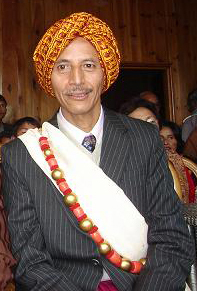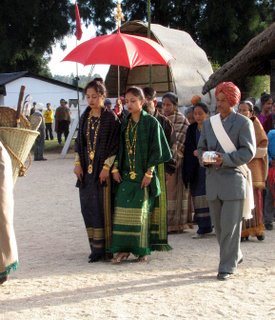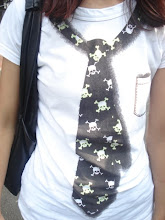Jaiñsem goes designer
The jaiñsem has finally gone designer, but the cost that ranges from Rs.500 to Rs.2000 will be within the reach of the masses. The traditional dress of Khasi women is set to become a hot attraction on the fashion ramps of the rich and the famous if Shillong seamstress Sangita Agarwall has her way. Displaying the first designer jaiñsem to be ever made, Aggarwal’s creations drew gasps of admiration from the women visiting the two-day Style Mantraz Exhibition, at the All Saints Cathedral Hall recently.Each designer jaiñsem was created in raw silk and exquisitely embroidered with intricate zariwork of all hues, woven by craftsmen in Mumbai and Kolkata. The finishing touches to the embroidery were of course done by Aggarwal to give the distinct flavour of a designer label. Agarwal, 39, who came to Shillong as a young bride of a Marwari businessman and has two teenaged children, told The Meghalaya Guardian that she hit on the designer jaiñsem idea when she was asked to conceive creations for the Mrs. Shillong contest this year. Before that, Aggarwal was content to make cushion covers and other household drapery.“I designed jaiñsem so as to give it a modern look, without diluting its ethnic authenticity,” Aggarwal said,  adding, “It is a renovation of culture.” The casual jaiñsem of everyday wear is from mill-cloth that is widely available in the market and in need of a new look, unlike the Dhara which is made from fine silk and worn on festive and very special occasions by the Khasis.Women visiting the exhibition agreed that there is a need for a change and that the young preferred to follow modern concepts of fashion. L. Shangpliang, a lecturer at St. Mary’s College said: “We are to make change in our lifestyle and keep up with the fashion trends.” With modern girls opting more and more for western clothes, the jaiñsem is fast becoming formal wear for the elders. It was not always this way. Historically, the jaiñsem originated from the jaiñkyrshah, which served as an apron or a pinafore and worn inside the home and in the fields by the Khasi and Jaiñtia women since time immemorial. Then, the cloth was cotton, of small square patterns.Khasi man had in the past had worn unstitched lower garment (dhoti), jacket and turban, but that has been all but sacrificed to the needs of modern society. They now wear western clothes, unlike the women, who have retained their traditional dress, called the jaiñsem, which consists of an undergarment, and above it, a two-piece cloth of two meters, pinned on each shoulder.
adding, “It is a renovation of culture.” The casual jaiñsem of everyday wear is from mill-cloth that is widely available in the market and in need of a new look, unlike the Dhara which is made from fine silk and worn on festive and very special occasions by the Khasis.Women visiting the exhibition agreed that there is a need for a change and that the young preferred to follow modern concepts of fashion. L. Shangpliang, a lecturer at St. Mary’s College said: “We are to make change in our lifestyle and keep up with the fashion trends.” With modern girls opting more and more for western clothes, the jaiñsem is fast becoming formal wear for the elders. It was not always this way. Historically, the jaiñsem originated from the jaiñkyrshah, which served as an apron or a pinafore and worn inside the home and in the fields by the Khasi and Jaiñtia women since time immemorial. Then, the cloth was cotton, of small square patterns.Khasi man had in the past had worn unstitched lower garment (dhoti), jacket and turban, but that has been all but sacrificed to the needs of modern society. They now wear western clothes, unlike the women, who have retained their traditional dress, called the jaiñsem, which consists of an undergarment, and above it, a two-piece cloth of two meters, pinned on each shoulder.
 adding, “It is a renovation of culture.” The casual jaiñsem of everyday wear is from mill-cloth that is widely available in the market and in need of a new look, unlike the Dhara which is made from fine silk and worn on festive and very special occasions by the Khasis.Women visiting the exhibition agreed that there is a need for a change and that the young preferred to follow modern concepts of fashion. L. Shangpliang, a lecturer at St. Mary’s College said: “We are to make change in our lifestyle and keep up with the fashion trends.” With modern girls opting more and more for western clothes, the jaiñsem is fast becoming formal wear for the elders. It was not always this way. Historically, the jaiñsem originated from the jaiñkyrshah, which served as an apron or a pinafore and worn inside the home and in the fields by the Khasi and Jaiñtia women since time immemorial. Then, the cloth was cotton, of small square patterns.Khasi man had in the past had worn unstitched lower garment (dhoti), jacket and turban, but that has been all but sacrificed to the needs of modern society. They now wear western clothes, unlike the women, who have retained their traditional dress, called the jaiñsem, which consists of an undergarment, and above it, a two-piece cloth of two meters, pinned on each shoulder.
adding, “It is a renovation of culture.” The casual jaiñsem of everyday wear is from mill-cloth that is widely available in the market and in need of a new look, unlike the Dhara which is made from fine silk and worn on festive and very special occasions by the Khasis.Women visiting the exhibition agreed that there is a need for a change and that the young preferred to follow modern concepts of fashion. L. Shangpliang, a lecturer at St. Mary’s College said: “We are to make change in our lifestyle and keep up with the fashion trends.” With modern girls opting more and more for western clothes, the jaiñsem is fast becoming formal wear for the elders. It was not always this way. Historically, the jaiñsem originated from the jaiñkyrshah, which served as an apron or a pinafore and worn inside the home and in the fields by the Khasi and Jaiñtia women since time immemorial. Then, the cloth was cotton, of small square patterns.Khasi man had in the past had worn unstitched lower garment (dhoti), jacket and turban, but that has been all but sacrificed to the needs of modern society. They now wear western clothes, unlike the women, who have retained their traditional dress, called the jaiñsem, which consists of an undergarment, and above it, a two-piece cloth of two meters, pinned on each shoulder.
 holders of our own cultural heritage we manage to strike a balance” Dr. Balajied Sing Syiem, King of the Hima Khyrim told The Meghalaya Guardian as he hosted the festival of traditional importance for hundreds of people gathered at Smit on the third day of the festival on Friday.Armed with a campaign to preserve Khasi culture, the Syiem, who enjoys great prestige amongst his people, is no ordinary King to carry out his routine duties within his council. Dressed in suit and tie, and speaking flawless English, the Syiem is a physician by profession. He expressed his concern for a wide range of issues affecting his people, ranging from education, job opportunities and infrastructure. Tracing the origin of his kingdom the Syiem said that the Hima Khyrim separated from the Hima Shyllong in 1853, and now extends from Karbi Anglong in the North to Pyrdiwah in the South with over 400 villages and a population of 2 lakh. “The Hima Khyrim is very much alive, walking side by side with change,” he said.Not just the King, but his sister who is the Queen also pursues a profession as a principal of a high school in Smit. But the siblings do not let the worldly profession interfere with the discharge of their traditional duties to uphold the welfare of the people and maintain the rituals and traditions of their ancient culture.
holders of our own cultural heritage we manage to strike a balance” Dr. Balajied Sing Syiem, King of the Hima Khyrim told The Meghalaya Guardian as he hosted the festival of traditional importance for hundreds of people gathered at Smit on the third day of the festival on Friday.Armed with a campaign to preserve Khasi culture, the Syiem, who enjoys great prestige amongst his people, is no ordinary King to carry out his routine duties within his council. Dressed in suit and tie, and speaking flawless English, the Syiem is a physician by profession. He expressed his concern for a wide range of issues affecting his people, ranging from education, job opportunities and infrastructure. Tracing the origin of his kingdom the Syiem said that the Hima Khyrim separated from the Hima Shyllong in 1853, and now extends from Karbi Anglong in the North to Pyrdiwah in the South with over 400 villages and a population of 2 lakh. “The Hima Khyrim is very much alive, walking side by side with change,” he said.Not just the King, but his sister who is the Queen also pursues a profession as a principal of a high school in Smit. But the siblings do not let the worldly profession interfere with the discharge of their traditional duties to uphold the welfare of the people and maintain the rituals and traditions of their ancient culture.



